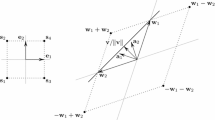Abstract
In this paper we are concerned with characterizing minimal representations of feasible regions defined by both linear and convex quadratic constraints. We say that representation is minimal if every other representation has either more quadratic constraints, or has the same number of quadratic constraints and at least as many linear constraints. We will prove that a representation is minimal if and only if it contains no redundant constraints, no pseudo-quadratic constraints and no implicit equality constraints. We define a pseudo-quadratic constraint as a quadratic constraint that can be replaced by a finite number of linear constraints. In order to prove the minimal representation theorem, we also prove that if the surfaces of two quadratic constraints match on a ball, then they match everywhere.
In this paper we also provide algorithms that can be used to detect implicit equalities and pseudoquadratic constraints. The redundant constraints can be identified using the hypersphere directions (HD) method.
Similar content being viewed by others
References
D.P. Baron, “Quadratic programming with quadratic constraints,”Naval Research Logistics Quarterly 19 (1972) 105–119.
A. Boneh and A. Golan, “Constraint redundancy and feasible region boundedness by a random feasible point generator (RFPG),” contributed paper, EURO III (Amsterdam, April 1979).
R.J. Caron, M. Hlynka and J.F. McDonald, “On the best case performance of hit and run methods for detecting necessary constraints,”Mathematical Programming 54 (1992) 233–249.
R.J. Caron, J.F. McDonald and C.M. Ponic, “A degenerate extreme point strategy for the classification of linear constraints as redundant or necessary,”Journal of Optimization Theory and Applications 62 (1989) 225–237.
R.J. Caron and W.T. Obuchowska, “Quadratically constrained convex quadratic programmes: Faulty feasible regions,” Technical Report WMSR 92-05, Department of Mathematics and Statistics, University of Windsor (Windsor, Ont., 1992).
F. Cole, J.G. Ecker and W. Gochet, “A reduced gradient method for quadratic programs with quadratic constraints andl p -constrainedl p -approximation problems,”European Journal of Operational Research 9 (1982) 194–203.
J.G. Ecker and R.D. Niemi, “A dual method for quadratic programs with quadratic constraints,”SIAM Journal of Applied Mathematics 28 (1974) 568–576.
U. Eckhardt, “Representation of Convex Sets,” Proceedings of International Symposium on External Methods and Systems Analysis (Austin, Texas, 1979).
S.C. Fang and J.R. Rajasekera, “Controlled perturbations for quadratically constrained quadratic programs,”Mathematical Programming 36 (1986) 276–289.
D. Goldfarb, S. Liu and S. Wang, “A logarithmic barrier function algorithm for quadratically constrained convex quadratic programming,”SIAM Journal on Optimization 1 (1991) 252–267.
W. Hock and K. Schittkowski,Test Examples for Nonlinear Programming Codes (Springer, Berlin, 1980).
F. Jarre, “On the convergence of the method of analytic centers when applied to convex quadratic programs,”Mathematical Programming 49 (1990/91) 341–358.
S. Mehrotra and J. Sun, “A method of analytic centres for quadratically constrained convex quadratic programmes,”SIAM Journal on Numerical Analysis 28 (1991) 529–544.
E. Phan-huy-Hao, “Quadratically constrained programming: some applications and a method for solution,”Zeitschrift für Operations Research 8 (1982) 105–119.
A. Schrijver,Theory of Linear and Integer Programming (J. Wiley, New York, 1986).
J. Telgen, “Minimal representation of convex polyhedral sets,”Journal of Optimization Theory and Applications 38 (1982) 1–24.
J. Telgen, “Identifying redundant constraints and implicit equalities in systems of linear constraints,”Management Science 29 (1983) 1209–1222.
C.R. Vogel, “A constrained least squares method for nonlinear ill-posed problems,”SIAM Journal on Control and Optimization 28 (1990) 34–49.
Author information
Authors and Affiliations
Additional information
Corresponding author.
Rights and permissions
About this article
Cite this article
Obuchowska, W.T., Caron, R.J. Minimal representation of quadratically constrained convex feasible regions. Mathematical Programming 68, 169–186 (1995). https://doi.org/10.1007/BF01585763
Received:
Revised:
Issue Date:
DOI: https://doi.org/10.1007/BF01585763




